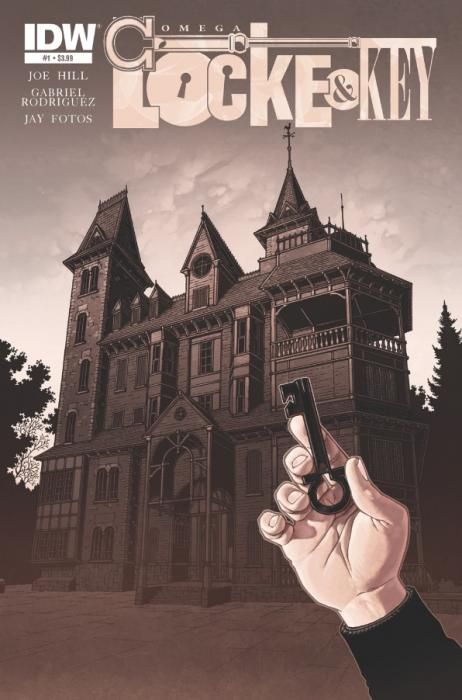"Locke and Key: Omega" #1 begins the final arc of Joe Hill and Gabriel Rodriguez's superb family-centric, artifact-strewn horror saga. It's a great issue that runs contrary to reader expectations.
At the end of "Locke and Key: Clockworks," the villain got her or his hands on the ultimate and most important key. It seemed as if Hill would launch straight into Dodge kicking off an epic storm of events, but instead, "Locke and Key: Omega" #1 shines the spotlight almost entirely on the good guys: the Locke family, their friends and associates.
Hill doesn't actually leave readers in suspense, as the story picks up directly after the cliffhanger at the end of "Locke and Key: Clockworks" #6. A fully empowered Dodge begins the issue with a scene that gets dramatic punch from some off-screen mayhem and some extra shock from Rodriguez's deft use of scale and camera angles. Immediately afterwards, however, the story takes an unexpected turn into relatively ordinary life of students, and the bulk of the issue doesn't advance the epic horror action by much. Dragging out conflict usually feels like padding, but Hill's choice to make "Locke and Omega" #1 focus the current thoughts of the Lockes increases the suspense in the best way possible - by raising the stakes.
Scot Kavanaugh walks around with a video camera, asking senior classmates the same question. This is a well-worn framing and plotting trope, usually seen in films with a high school setting as kids approach graduation, but Hill fills his characters' answers with raw emotion and Rodriguez draws that emotion in their faces so well, that they make this plot device work marvelously for the story they want to tell.
Hill shuffles and deals out his deck of characters well, too, beginning with Scot asking Tyler his question, but it's interrupted. Scot gets increasingly revealing answers and footage from other characters, before returning to Tyler for the knockout emotional climax of Tyler's answer, with the follow-up punch of Kinsey getting her turn even though she isn't a senior. The catharsis in this issue is huge as several characters bare their souls and reveal layers of thought and feeling that readers weren't privy to before now. Tyler and Kinsey's answers are moving for their honesty and bravery, and their respective self-insight is remarkable.
In "Locke and Key," Hill has made the family's emotional burdens and distress sometimes tangible through magical artifacts, but here, the characters own their emotions and display them in the usual human ways -- through eyes, through faces, through tears. Hill's choice to stick to understated realism for these scenes makes them more powerful, and the Lockes seem more like flesh and blood people than ever before, as the supernatural elements of their lives are momentarily diminished and bonds begin to mend.
Rodriguez does some fantastic work in "Locke and Key: Omega" #1. Save for the opening scene, it's all faces and emotions. Rodriguez keeps up great background detail and natural shifts of camera angle, but his most impressive work is in the far-away, sad eyes of Tyler Locke as the character chooses to answer Scot's question with a story about a party.
Hill's wry humor also infuses the dialogue, and with Rodriguez, the story dances from shock to sincerity to humor without any missteps. For those who enjoy these things, there a great Easter Egg in the panel with an ambulance. At natural intervals, the action shifts briefly to Dodge and his or her incremental but steady progress, and the issue ends with an ominous image of Dodge's calm exultation in success.
Readers who have been following the series won't be disappointed in the well-crafted, intimate "Locke and Key: Omega" #1. New readers should pick up a trade or hardcover the first storyline, "Welcome to Lovecraft," and treat themselves a story by one the best creative teams in comics.

